Servlets are Java programs that run on a web or application server and act as a middle layer between a request coming from a web browser or other HTTP client and databases or applications on the HTTP server. Servlets receive HTTP requests and return HTTP responses by accepting request parameters, generating dynamic content, accessing databases, and performing network communications using Java. Servlets are commonly used to add dynamic content to web pages and to access backend databases. The lifecycle of a servlet involves initialization, servicing client requests, and destruction. Common servlet APIs include classes for handling HTTP requests and responses, reading request parameters, using cookies and sessions.
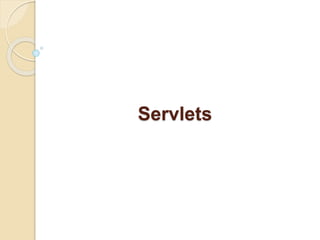



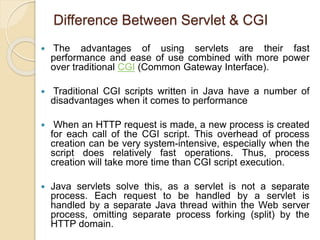
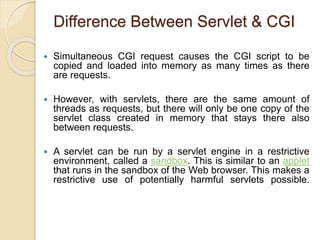

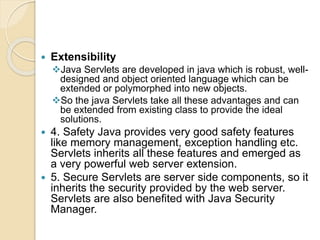

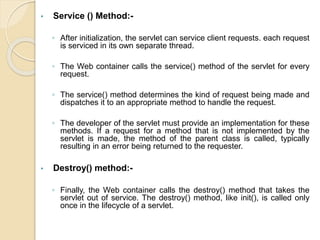











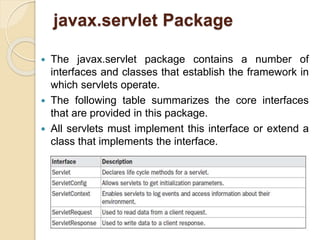
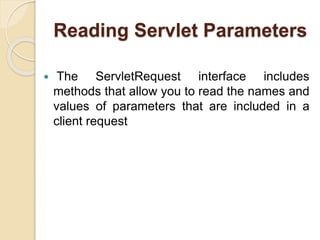
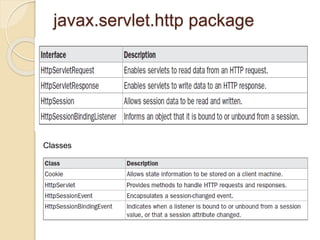





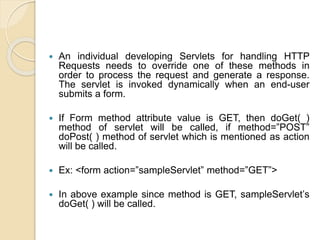


![ getParameter ( ) method is used to access single
value, takes name of input parameter as an argument
and returns a string object.
Ex: String s=req.getParameter(“user”);
getParameterValues ( ) method is used to access
multiple value entered by user in a client program, it
takes name of input parameter as an argument and
returns a array of string object.
Ex: String [ ] lang=req.getParameterValues
(“language”);](https://image.slidesharecdn.com/chapter3servletjsp-140510052401-phpapp01/85/Chapter-3-servlet-jsp-33-320.jpg)
![When we want to access all the parameters of a form, we make
use of Enumeration object and its methods as shown below.
Ex: Enumeration en;
String pname;
String pvalue;
en = request.getParameterNames();
while (en.hasMoreElements())
{
pname = (String) en.nextElement();
pvalue= request.getParameterValues(pname);
for(int i=0;i<pvalue.length;i++)
{
out.println(pvalue[i]);
}
}](https://image.slidesharecdn.com/chapter3servletjsp-140510052401-phpapp01/85/Chapter-3-servlet-jsp-34-320.jpg)
![Cookies
Cookies are small bits of textual information that a Web
server sends to a browser and that the browser returns
unchanged when visiting the same Web site or domain
later.
To send cookies to the client, a servlet would create one or
more cookies with the appropriate names and values via
new Cookie(name, value).
A Cookie is created by calling the Cookie constructor, which
takes two strings: the cookie name and the cookie value.
Neither the name nor the value should contain whitespace
or any of: [ ] ( ) = , " / ? @ : ;
Ex: Cookie userCookie = new Cookie("user", "uid1234");](https://image.slidesharecdn.com/chapter3servletjsp-140510052401-phpapp01/85/Chapter-3-servlet-jsp-35-320.jpg)


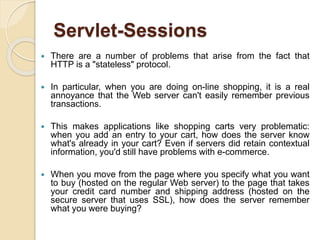







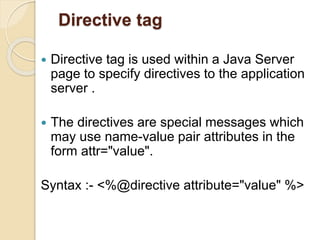


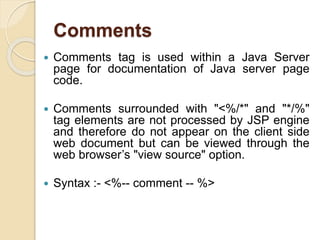
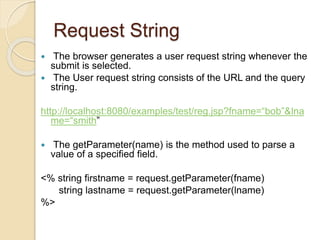


![HOW TO READ A COOKIE
<HTML>
<HEAD>
<TITLE> JSP Programming</TITLE>
</HEAD>
<BODY>
<%! String MyCookieName=“userID”;
String MyCookieValue;
String Cname,Cvalue;
int found=0;
Cookie[] cookies=request.getCookies();
for(int i=0;i<cookies.length;i++){
CName=cookies[i].getName();
CValue= cookie[i].getValue();
if(MyCookieName.equals(cookieNames[i])){
found=1;
MyCookieValue=CookieValue;
}
}
if(found==1){ %>
<p> Cookie name =<% MYCookieName%></p>
<p> Cookie Value=<% MyCookieValue %></p>
<&}>
</BODY>
</HTML>](https://image.slidesharecdn.com/chapter3servletjsp-140510052401-phpapp01/85/Chapter-3-servlet-jsp-53-320.jpg)
